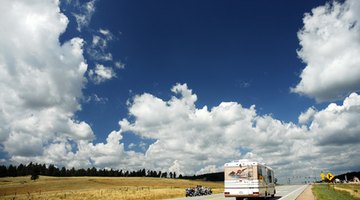How Do I Build a Roof Over a Camper for Winter Storage?
Winter can be hard on vehicles, especially campers. Snow and ice buildups can damage the exterior of the vehicle, and extreme temperature swings can cause problems for tires. Cold temperatures can also cause pipes to freeze and wreak havoc with the plumbing.

Finally, you're not the only creature that appreciates a warm home in the winter -- mice, woodchucks, raccoons and other small animals have been known to use campers as winter homes. A well-built roof over your camper can reduce or eliminate many of these problems.
Things You Will Need
- Shovel
- 4 posts, 4-inch-by-4-inch-by-12-feet
- Concrete mix
- Water
- 4 boards, 2-inch-by-4-inch-by-12-feet
- 4 boards, 2-inch-by-4-inch-by-16-feet
- Ladder
- Level
- Tape measure
- Hammer
- Nails
- Saw
- 6 panels tin or plastic roofing, 4-foot-by-8-foot sheets
- 4 boards, 2-inch-by-4-inch-by-16-feet (optional, for cross-braces)
-
Dig holes for the posts. The holes should be at least 1 foot deep. Set the posts in holes 8 or 12 feet from each other to form a rectangular outline. Measure the height from the ground to the top post to make sure your camper will fit. Mix the concrete with water according to the manufacturer's instructions and pour it into the holes. Let the concrete dry overnight.
-
Nail the four 2-inch-by-4-inch-by-12-foot boards to the top of the posts. If you live where snowfall is heavy, you may want to cut a foot or two off two posts to slant the roof before placing the frame boards around the top of the posts.
-
Secure the four 2-inch-by-4-inch-by-16-foot boards to the top of the frame as rafters. Space the rafters at even intervals along the 12-foot length of the frame, leaving a 2-foot overhang on either side.
-
Nail the roof panels to the rafters. Galvanized 5d nails, 1 3/4 inches in length, should be used. Overlap panels to avoid rain from seeping in through cracks. Use at least one nail per foot to keep the roof from blowing off in windy weather.
-
Test the structure to make sure it's solid by pushing on the four corner posts. If it wobbles, build cross-braces along the length of the structure. Measure a diagonal across the two long sides and one short side of the frame. Cut two 2-inch-by-4-inch-by-16-foot boards for each diagonal, nailing one to the inside of the frame and one to the outside. The bracing boards should intersect in the middle of the diagonal.
Tip
Use 16-foot posts if your RV is taller than 11 feet. You can also use lightweight plywood sheets to cover the sides of the shelter if you want more protection than just a roof offers.
Warning
Build your camper shelter on level, well-drained ground.
The Drip Cap
- Winter can be hard on vehicles, especially campers.
- Snow and ice buildups can damage the exterior of the vehicle, and extreme temperature swings can cause problems for tires.
- Set the posts in holes 8 or 12 feet from each other to form a rectangular outline.
- Secure the four 2-inch-by-4-inch-by-16-foot boards to the top of the frame as rafters.
- Use at least one nail per foot to keep the roof from blowing off in windy weather.
References
Photo Credits
- rv on highway image by jedphoto from Fotolia.com
- rv on highway image by jedphoto from Fotolia.com
More Articles


